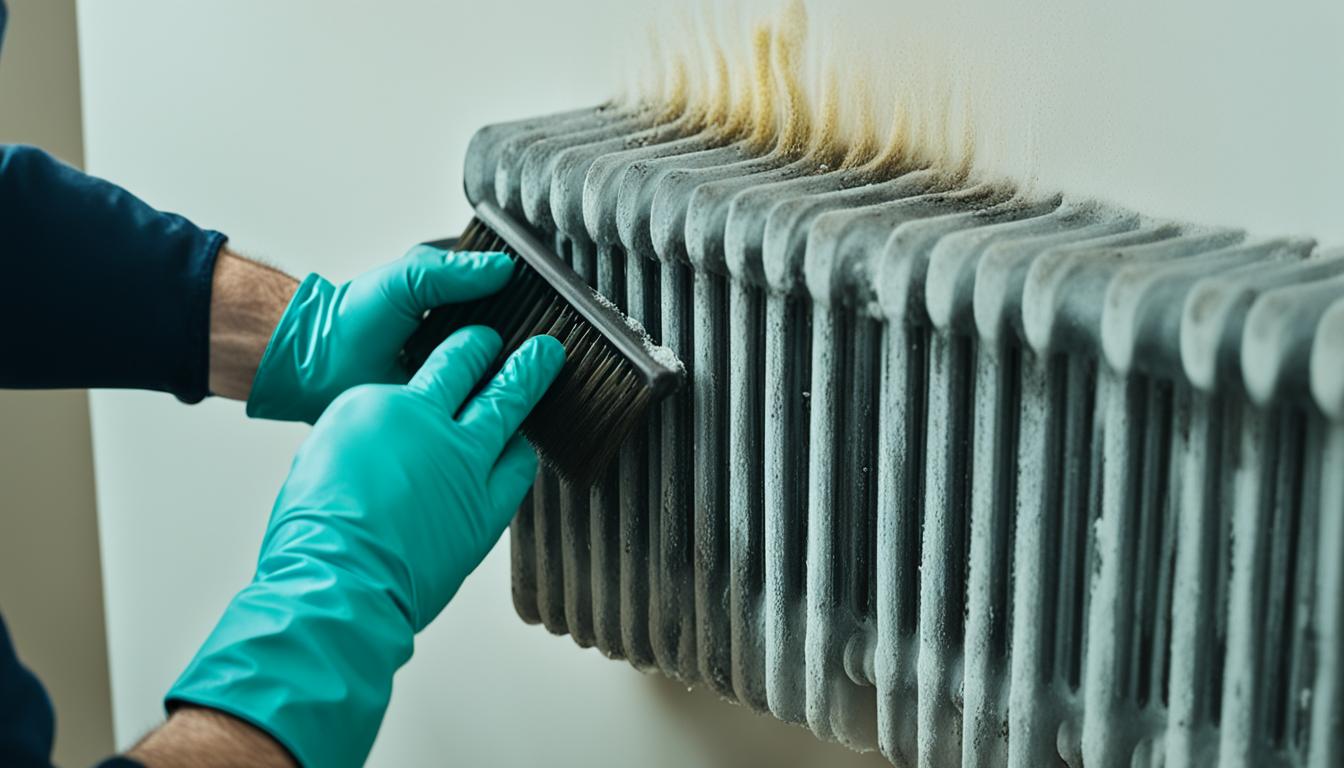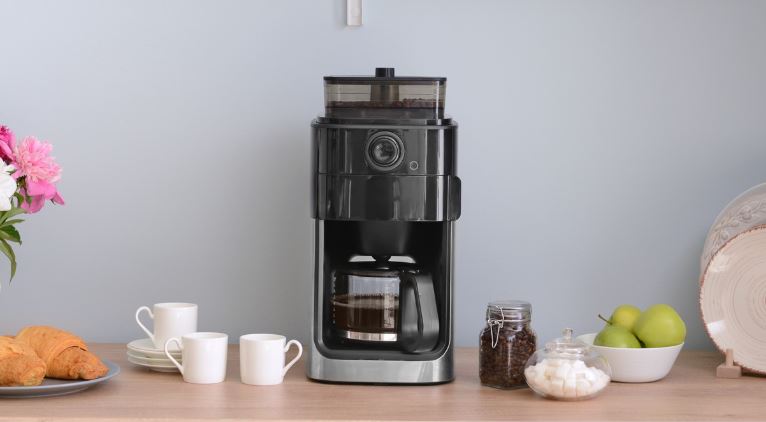Welcome to our comprehensive guide on how to clean inside a radiator. Cleaning radiators is not only about improving their appearance but also optimizing their heating efficiency. By removing accumulated dirt, dust, and grime, you can ensure that your heating system operates at its best, providing consistent warmth in every room.
In this guide, we will provide you with valuable radiator cleaning tips, maintenance advice, and DIY cleaning techniques to keep your radiators in top shape.
The Importance of Cleaning Radiators
Dust, debris, and greasy fingerprints can accumulate on radiators, impacting their energy-efficiency, appearance, and even causing odors. Regular cleaning is essential to maintain a healthy living environment and save on energy bills.
When radiators are not regularly cleaned, dirt and dust particles can settle on the surface and within the radiator fins. This accumulation acts as an insulator, preventing efficient heat transfer and reducing the radiator’s ability to warm your home effectively. As a result, your central heating system needs to work harder and consume more energy to reach the desired temperature.
In addition to compromising energy-efficiency, a dirty radiator can also affect indoor air quality. Dust, allergens, and other particles that accumulate on the radiator can get circulated around your home, leading to respiratory issues and allergies. Cleaning radiator at home on a regular basis can help alleviate these problems and create a cleaner, healthier living environment for you and your family.
Moreover, neglecting radiator cleaning can lead to unpleasant odors. The combination of dust, grime, and moisture can create a breeding ground for bacteria and mold, resulting in musty smells emanating from your radiators. By removing dirt from radiators, you can prevent these odors and ensure a fresh-smelling home.
Cleaning radiators is an essential part of home maintenance, and it doesn’t have to be a daunting task. With a few simple steps and the right tools, you can easily remove dirt and debris, improving the efficiency of your heating system while maintaining a clean and pleasant living environment.
Tools and Supplies for Radiator Cleaning
When it comes to cleaning radiators, having the right tools and supplies can make the process much easier and more effective. Here are the essential items you’ll need to clean both the surface and inside of your radiator:
- Radiator brush or long-handled duster: A radiator brush or a long-handled duster will help you reach the nooks and crannies of the radiator, ensuring thorough cleaning.
- Soft sponges or microfiber cloths: Use soft sponges or microfiber cloths to wipe down the visible surfaces of the radiator. These materials are gentle enough to avoid scratching but effective at removing dust and grime.
- Warm water: Warm water is ideal for cleaning radiators as it helps to loosen dirt and debris.
- Gentle soap or white vinegar: Mix warm water with a gentle soap or white vinegar to create a cleaning solution. Both options are effective at breaking down dirt and grime.
- Bucket: Fill a bucket with warm water and your chosen cleaning solution. This will serve as your cleaning station, making it easy to apply the solution.
- Towel: Keep a towel nearby to wipe up any excess water or cleaning solution.
- Optional: Vacuum with a brush attachment: A vacuum cleaner with a brush attachment can be useful for removing dust and debris from hard-to-reach areas. This step is optional but recommended for a thorough clean.
By using these radiator cleaning tools and supplies, you’ll be equipped to tackle both the visible surfaces and the inside of your radiator, ensuring a clean and efficient heating system.

| Radiator Cleaning Tools | Description |
|---|---|
| Radiator brush or long-handled duster | A tool with soft bristles or a long handle to reach narrow spaces and clean the radiator’s convector fins. |
| Soft sponges or microfiber cloths | Non-abrasive cleaning materials that effectively remove dirt and grime without damaging the radiator’s surface. |
| Warm water | Water at a comfortable temperature that helps to loosen dirt and debris for easy removal. |
| Gentle soap or white vinegar | A mild cleaning solution that breaks down dirt and grime without causing damage to the radiator. |
| Bucket | A container for holding the cleaning solution, making it easy to apply to the radiator. |
| Towel | A cloth for drying the radiator or wiping up any excess water or cleaning solution. |
| Optional: Vacuum with a brush attachment | A vacuum cleaner with a brush attachment can help remove dust and debris from hard-to-reach areas of the radiator. |
Step-by-Step Guide to Cleaning a Radiator
Proper cleaning and maintenance of your radiator are essential to ensure optimal performance and longevity. By following these step-by-step instructions, you can effectively clean your radiator and keep it in top condition.
- Switch off the central heating: Before you begin cleaning, make sure to turn off the central heating system. This will prevent any accidents or mishaps while you work on the radiator.
- Dust the radiator: Start by removing any dust or debris from the surface of the radiator. You can use a vacuum cleaner with a brush attachment or a soft duster for this step. Pay special attention to the areas between the fins and any hard-to-reach spots.
- Mix a cleaning solution: Prepare a cleaning solution by combining mild soap or white vinegar with warm water. This solution will help break down any stains or grime on the radiator surface.
- Clean the surface: Dip a clean cloth or sponge into the cleaning solution and wring out any excess liquid. Gently wipe the surface of the radiator, ensuring that you cover every area. Use circular motions and apply light pressure to remove any dirt or residue.
- Rinse and wipe: After cleaning the radiator with the soapy solution, rinse the cloth or sponge with clean water. Wipe down the radiator surface again to remove any remaining soap or vinegar residue.
- Dry the radiator: It’s important to thoroughly dry the radiator before turning the heating system back on. Use a dry cloth or towel to remove any moisture from the surface. You can also let the radiator air dry for a while to ensure it’s completely dry.
Following these cleaning instructions and best radiator cleaning methods will help you maintain a clean and efficient radiator. Regular cleaning, along with proper radiator maintenance guidelines, will ensure that your radiator continues to provide consistent warmth and efficiently heat your home.
How to Clean a Radiator with a Top Grill?
Radiators with top grills require special cleaning techniques to ensure optimal performance. Here’s a step-by-step guide to effectively clean the radiator with a top grill:
1. Access the Convector Fins and Hard-to-Reach Areas
Start by using a radiator brush to access the convector fins and clean the hard-to-reach areas. Gently brush away any dust, dirt, or debris that may have accumulated. Pay close attention to the spaces between the fins to ensure thorough cleaning.
2. Remove and Clean the Top Grill (If Removable)
If the top grill is removable, carefully take it off to clean it separately. This will allow you to access the inner parts of the radiator easily. Clean the grill using warm soapy water or a mixture of water and white vinegar. Use a cloth or sponge to remove any dirt or grime and rinse it thoroughly before reattaching it to the radiator.
3. Maintenance and Sludge Removal
Regular maintenance is essential for preventing sludge buildup and ensuring the radiator’s efficient operation. To remove sludge from the radiator pipes, consider using a sludge cleaner or flushing agent. Follow the instructions provided by the manufacturer to safely and effectively remove sludge deposits.

Be mindful of any warning signs of sludge accumulation, such as cold spots on the radiator and reduced heat output. Addressing sludge buildup promptly will help maintain the efficiency of your radiator and prevent potential heating issues.
4. Final Cleaning and Inspection
After cleaning the top grill and convector fins, use a damp cloth or sponge to wipe down the radiator’s exterior surface. Pay attention to any visible dust or stains and remove them gently. Ensure that the radiator is completely dry before turning the heating system back on.
Cleaning a radiator with a top grill may require some extra effort, but it’s crucial for maintaining its performance and prolonging its lifespan. By following these cleaning techniques, you can keep your radiator clean and efficient, ensuring consistent heat distribution throughout your home.
Cleaning Radiator Fins
Radiator convector fins are essential for enhancing heat exchange efficiency in radiators. These fins facilitate the transfer of heat from the radiator to the surrounding air, ensuring effective heating in your home. It is crucial to keep these fins clean to maintain optimal radiator function and prevent blockages.
To effectively clean radiator fins, there are a few simple steps you can follow:
- Start by using a radiator brush or long-handled duster to gently remove dust, debris, and pet hair from the fins. Make sure to be thorough and cover all areas to ensure optimal cleaning.
- An alternative option is to use a vacuum cleaner with a brush attachment. This can help to remove finer particles and provide a deeper clean.
- Regular cleaning of radiator fins is essential to prevent blockages that can hinder heat transfer. By removing dirt and debris, you allow for efficient airflow and heat distribution throughout your home.
By incorporating regular cleaning of radiator fins into your maintenance routine, you can ensure that your radiators operate at their best and provide effective heating. It is a simple yet significant step towards maintaining a comfortable living environment.
Expert Tip:
When cleaning radiator fins, make sure to avoid using harsh chemicals or abrasive materials that may damage the fins or the radiator’s surface. Stick to gentle cleaning tools and methods to protect the radiator’s functionality and appearance.
For a visual representation of radiator fins and how they contribute to heat exchange efficiency, take a look at the image below:
Benefits of Cleaning Radiator Fins
| Benefits | Explanation |
|---|---|
| Improved Heating Efficiency | Clean radiator fins allow for better heat transfer, resulting in more effective heating throughout your home. |
| Prevention of Blockages | Regular cleaning prevents the accumulation of dirt and debris that can cause blockages and hinder heat distribution. |
| Extended Radiator Lifespan | Proper maintenance, including cleaning the fins, helps prolong the lifespan of your radiator, saving you money on replacements. |
| Enhanced Energy Efficiency | A clean radiator operates more efficiently, reducing energy consumption and lowering heating costs. |
By regularly cleaning your radiator fins, you can enjoy improved heating performance, energy efficiency, and a longer lifespan for your radiators. Make it a part of your regular maintenance routine to ensure a comfortable and cost-effective heating experience.
How to Clean a Chrome Radiator?
Chrome radiators require special care to maintain their appearance and heat transfer efficiency. To keep your chrome radiator clean and pristine, follow these steps:
Gather the necessary tools:
- A soft duster or radiator brush
- Warm soapy water
- White vinegar
- Clean cloth or sponge

Step-by-Step Cleaning Guide:
- Start by removing any loose dust from the radiator surface using a duster or radiator brush. Be gentle to avoid scratching the chrome finish.
- Mix warm soapy water or a solution of water and white vinegar in a bucket.
- Dampen a clean cloth or sponge with the soapy water or vinegar solution.
- Gently wipe the radiator surface, focusing on areas with dirt or grime buildup.
- Rinse the cloth or sponge with clean water and wipe the radiator again to remove any soap residue.
- Finally, dry the radiator thoroughly using a dry cloth or towel to prevent water spots or streaks.
Tip: Avoid using abrasive cleaners, harsh chemicals, or scrub brushes on chrome radiators as they can damage the finish.
By following these steps, you can effectively clean a chrome radiator and maintain its visual appeal and heat transfer efficiency. Remember to be gentle, use appropriate cleaning solutions, and always dry the radiator thoroughly to achieve the best results and protect the chrome finish.
Clean and Efficient Radiators for Lower Heating Costs
Keeping your radiators clean and well-maintained can help lower your heating costs. Dust and debris inside radiators can impede heat transfer and require your heating system to work harder. Regular cleaning, as well as occasional deep cleaning and maintenance, will ensure that your radiators operate efficiently and save you money on energy bills.
Proper radiator maintenance is crucial to optimizing their performance and longevity. To help you maintain clean and efficient radiators, here are some valuable tips:
Radiator Maintenance Tips:
- Regularly dust the exterior surface of the radiator using a soft cloth or microfiber duster. Removing the buildup of dust and pet hair will prevent it from entering the heat exchanger and blocking heat transfer.
- Vacuum the radiator fins and grills using a brush attachment. This will remove any loose debris and enhance the airflow, improving the efficiency of the radiator.
- Occasionally deep clean your radiators by using a radiator cleaning solution. Follow the manufacturer’s instructions for safe and effective cleaning.
- Check for any leaks or corrosion in the radiator. If you notice any issues, promptly address them to prevent further damage and maintain optimal performance.
By following these radiator maintenance tips, you can ensure that your radiators operate at their best. Not only will this result in lower heating costs, but it will also provide a comfortable and cozy home environment during the colder months.
In addition to regular radiator maintenance, it’s essential to implement the best radiator cleaning tips to maintain efficiency. Here are some effective techniques:
Best Radiator Cleaning Tips:
- Use a radiator brush or long-handled duster to clean between the fins and remove any trapped dirt or dust.
- If your radiator has a top grill, remove it and clean it separately to ensure thorough cleaning.
- Consider using a radiator flushing technique to remove any sludge or blockages that may hinder heat transfer. Consult a professional or follow specific instructions for safe and effective radiator flushing.
By incorporating these best radiator cleaning tips into your maintenance routine, you can ensure that your radiators remain clean, efficient, and cost-effective year-round.
Tips for Effective Radiator Cleaning
When it comes to radiator maintenance, regular cleaning is key to ensure optimal performance and longevity. Follow these tips to effectively clean your radiators and keep them in top shape:
- Clean them regularly: Regularly dust and wipe down your radiators to prevent the buildup of dust and dirt. This will help maintain their efficiency and prevent any blockages.
- Use appropriate tools and cleaning solutions: Use a soft cloth, sponge, or microfiber duster to gently clean the surface of your radiators. Avoid using abrasive materials or harsh chemicals that may damage the radiator’s finish.
- Be gentle: When cleaning your radiators, be gentle to avoid causing any damage. Avoid applying excessive force or using sharp objects that may scratch or dent the radiator surface.
- Consider deep cleaning and flushing: Periodically, consider deep cleaning your radiators to remove any accumulated sludge or debris that may impact their performance. Flushing the radiator system with a radiator flushing solution can help improve heat transfer and eliminate any blockages.
By following these radiator maintenance tips, including deep cleaning techniques and radiator flushing, you can ensure that your radiators operate efficiently and provide consistent heat throughout your home.

Professional Radiator Cleaning Services
If you prefer not to clean your radiators yourself or need a more thorough cleaning, you can hire professional radiator cleaning services. These services have the expertise and equipment to clean radiators effectively and ensure optimal performance.
Professional radiator cleaning services offer a range of solutions tailored to your specific needs. They possess in-depth knowledge of different radiator types and their cleaning requirements, allowing them to provide efficient and reliable services.
By hiring professional radiator cleaning services, you can benefit from:
- Expertise: Trained professionals possess extensive knowledge and experience in handling various radiator cleaning challenges. They understand the intricacies of different radiator systems and can apply appropriate cleaning techniques.
- Efficiency: Professionals have access to specialized equipment and tools specifically designed for radiator cleaning. These tools ensure a thorough clean without causing any damage to the radiators.
- Time savings: Cleaning radiators can be a time-consuming task, especially if you have multiple radiators or complex heating systems. Hiring professionals allows you to focus on other priorities while they take care of the cleaning process.
In addition to regular cleaning, professional radiator cleaning services may offer additional services such as radiator flushes. A radiator flush involves removing sludge and debris from the heating system, ensuring optimal performance and longevity.
When considering professional radiator cleaning services, it’s essential to choose a reputable and reliable provider. Research different companies in your area, read customer reviews, and compare prices to make an informed decision.
Investing in professional radiator cleaning services can not only enhance the performance of your radiators but also contribute to a more efficient heating system, ultimately resulting in cost savings and a comfortable living environment.
Conclusion
Regular maintenance and cleaning are crucial for optimizing the efficiency of your radiators and maximizing their heating performance. By following the step-by-step guide and utilizing the appropriate techniques, you can ensure that your radiators remain clean and free from obstructions. This will not only enhance their appearance but also save you money on heating costs.
Investing time in radiator maintenance and cleaning will pay off in the long run. It will prevent dust, debris, and sludge from accumulating inside your radiators, allowing for optimal heat transfer throughout your home. By regularly cleaning your radiators and adopting the best cleaning practices, you can enjoy a comfortable and energy-efficient living environment.
Remember, a well-maintained radiator is a reliable heating source. So, make it a part of your routine to care for your radiators diligently. By doing so, you can prolong their lifespan and ensure their continued performance. Keep this maintenance guide handy and enjoy the benefits of clean and efficient radiators in your home.
FAQ
How often should I clean my radiators?
It is recommended to clean your radiators at least once every few months to prevent dust and dirt buildup.
What tools do I need to clean a radiator?
To clean a radiator, you will need soft sponges or microfiber cloths, warm water, gentle soap or white vinegar, a bucket, a towel, a radiator brush or long-handled duster, and optionally, a vacuum with a brush attachment.
How do I clean the surface of a radiator?
Mix a cleaning solution of mild soap or white vinegar with warm water. Use a damp cloth to clean the surface of the radiator, then rinse and wipe it with clean water. Dry the radiator thoroughly before turning the heating system back on.
How do I clean radiator fins?
Use a radiator brush or long-handled duster to gently remove dust, debris, and pet hair from the radiator fins. A vacuum cleaner with a brush attachment can also be useful. Regular cleaning of radiator fins ensures optimal radiator function and prevents blockages.
How do I clean a radiator with a top grill?
Use a radiator brush to access the convector fins and hard-to-reach areas. If the top grill is removable, take it off and clean it separately. Cleaning the top grill and convector fins will help maintain the efficiency of the radiator.
How do I clean a chrome radiator?
Use a duster or radiator brush to remove loose dust. Then, wipe the radiator with warm soapy water or a mixture of water and white vinegar. Be gentle to avoid damaging the chrome finish.
How can cleaning radiators save on heating costs?
Dust and debris inside radiators can impede heat transfer and require your heating system to work harder. Regular cleaning, as well as occasional deep cleaning and maintenance, will ensure that your radiators operate efficiently and save you money on energy bills.
What are some tips for effective radiator cleaning?
Clean your radiators regularly to prevent dust and dirt buildup, use appropriate tools and cleaning solutions, be gentle to avoid damaging the radiator surface, and consider deep cleaning and flushing the radiator occasionally to remove sludge and improve heat transfer.
Can I hire professional radiator cleaning services?
Yes, if you prefer not to clean your radiators yourself or need a more thorough cleaning, you can hire professional radiator cleaning services. These services have the expertise and equipment to clean radiators effectively and ensure optimal performance.







